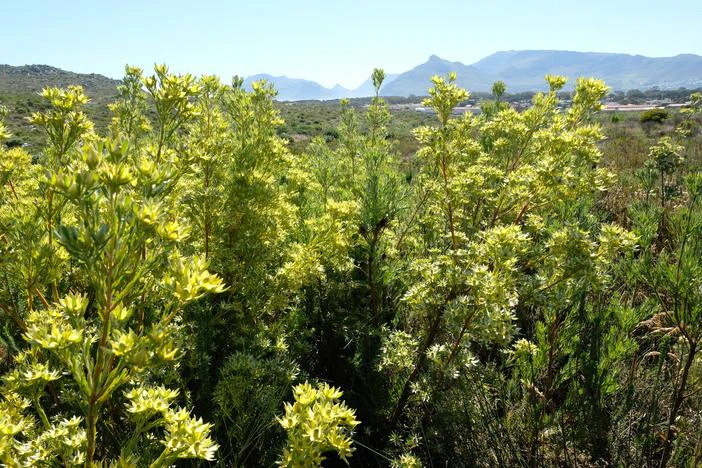Flats Conebush
(Leucadendron floridum)
Flats Conebush (Leucadendron floridum)
/
/

Nick Helme
CC BY-SA 4.0
Image By:
Nick Helme
Recorded By:
Copyright:
CC BY-SA 4.0
Copyright Notice:
Photo by: Nick Helme | License Type: CC BY-SA 4.0 | License URL: https://creativecommons.org/licenses/by-sa/4.0 | Uploader: Rooiratel | Publisher: Wikipedia Commons



































Estimated Native Range
Climate Requirements for Perth Amboy, New Jersey
| This Plant | Your Site | Plant Suitability for Your Location | ||
|---|---|---|---|---|
| • Precipitation | 12" - 27" | 48" | Aquatic | Aquatic |
| • High Temp. | 74°F - 88°F | 86°F | Your summer temperatures are normal for this plant. | Excellent |
| • Low Temp. | 39°F - 49°F | 22°F | Your winter temperatures may be too cold for this plant | Too cold |
This plant may not grow well at your location - your precipitation is too high.
Summary
Leucadendron floridum, commonly known as Flats Conebush, is an evergreen shrub native to the Cape Floristic Region, particularly the fynbos heathlands of southwestern South Africa. It typically grows to a height of 2 meters and is a member of the Proteaceae family. The Flats Conebush has a distinctive appearance with narrow, leathery leaves and bears cream-colored, inconspicuous flowers from September to October, which are followed by woody cones. The plant is dioecious, with separate male and female plants, and relies on wind pollination.
Flats Conebush is valued for its resilience to fire; while adult plants are killed by fire, their seeds survive, protected in woody cones (toll) on the female plants. These seeds are released post-fire, ensuring species regeneration. In cultivation, it is appreciated for its striking foliage and architectural form, making it suitable for ornamental gardens, xeriscaping, and as a focal point in drought-tolerant landscapes. It requires full sun, well-drained acidic soils, and moderate watering. While it is not commonly afflicted by diseases, it can be sensitive to root rot if overwatered or planted in poorly drained soils. It is not typically invasive when grown outside its native range but should be monitored to ensure it does not become a problem.CC BY-SA 4.0
Flats Conebush is valued for its resilience to fire; while adult plants are killed by fire, their seeds survive, protected in woody cones (toll) on the female plants. These seeds are released post-fire, ensuring species regeneration. In cultivation, it is appreciated for its striking foliage and architectural form, making it suitable for ornamental gardens, xeriscaping, and as a focal point in drought-tolerant landscapes. It requires full sun, well-drained acidic soils, and moderate watering. While it is not commonly afflicted by diseases, it can be sensitive to root rot if overwatered or planted in poorly drained soils. It is not typically invasive when grown outside its native range but should be monitored to ensure it does not become a problem.CC BY-SA 4.0
Plant Description
- Plant Type: Shrub
- Height: 3-6 feet
- Width: 3-6 feet
- Growth Rate: Moderate
- Flower Color: Cream, Green
- Flowering Season: Spring
- Leaf Retention: Evergreen
Growth Requirements
- Sun: Full Sun
- Water: Medium
- Drainage: Medium, Fast
Common Uses
Bee Garden, Drought Tolerant, Low Maintenance, Showy Flowers
Natural Habitat
Native to the fynbos heathlands of southwestern South Africa
Other Names
Common Names: Silky Euryspermum, Sunny Euryspermum, Tolbos
Scientific Names: Leucadendron floridum
GBIF Accepted Name: Leucadendron floridum R.Br.